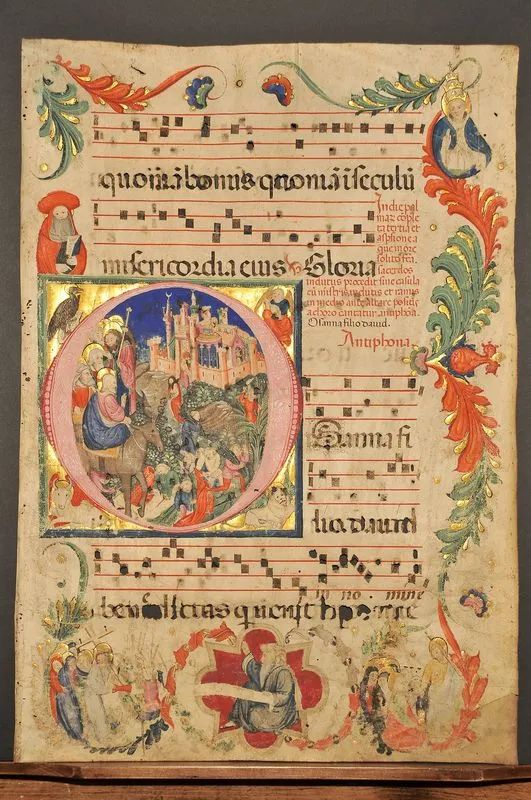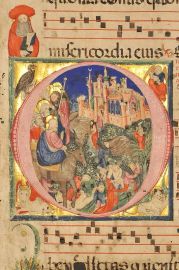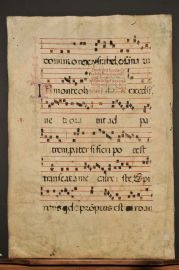MAESTRO DEL PONTIFICALE DI GIOVANNI BAROZZI,
INIZIALE "O",
ENTRATA DI CRISTO IN GERUSALEMME
Lombardia (Bergamo), terzo quarto del XV secolo
tempera su pergamena, foglio da antifonario, 545 x 370 mm, lettera iniziale 200 x 200 mm.
MASTER OF THE PONTIFICAL OF GIOVANNI BAROZZI,
HISTORIATED INITIAL "O"
THE ENTRANCE OF CHRIST IN JERUSALEM
Lombardy (Bergamo), third quarter of the 15th century
tempera on vellum, cutting from antiphonary, 545 x 370 mm, initial 200 x 200 mm.
"Scrittura gotica rotonda, notazioni musicali su tetragramma. Iniziale "I" rubricata in colore blu con disegni a penna sul verso del foglio. Iniziale "O", "Osanna filio david benedictus qui venit in nomine", antifona della domenica delle Palme. Precede l’antifona rubricato: "In die palmarum completa tertia et aspersione ague more solito sancta. Sacerdos indutus procedit sine casula cum ministris indutis et ramis in medio ante altare positis a choro cantatur antiphona Osanna filio david". La rubrica descrive l'ingresso del sacerdote, secondo il rito liturgico della domenica delle Palme, con l'aspersione dell'acqua santa e la collocazione dei rami di palma sull'altare, mentre viene intonato il canto dell'Osanna. (Qualche foro causato dall'inchiostro, abrasioni alla parte inferiore del foglio).
Al centro è rappresentato entro un compasso polilobato il profeta Isaia con un lungo cartiglio, mentre indica con la destra l'episodio rappresentato nell’iniziale con l'Entrata di Cristo in Gerusalemme. Cristo benedicente e accompagnato dai suoi discepoli avanza verso Gerusalemme accolto da una folla festante che al suo passaggio stende a terra le vesti, mentre un poco distante tre giovani stanno tagliando dei rami di palma. La città santa di Gerusalemme è rappresentata in lontananza, chiusa nel perimetro delle sue mura con torri quadrangolari. Il simbolo della mezzaluna, visibilmente ripetuto sulle torri più alte, le identifica come città non più cristiana. Tra gli edifici facilmente riconoscibile è la struttura a pianta centrale del Santo Sepolcro sulla cui sommità sono rappresentati due personaggi inturbantati. Sullo sfondo dorato, che riquadra l'iniziale, sono dipinti i simboli dei quattro Evangelisti, mentre al di sopra della lettera S. Gerolamo, rappresentato con il galero cardinalizio, ripete lo stesso gesto di Isaia, indicando l'episodio narrato nella lettera iniziale. A sinistra e a destra nel margine inferiore del foglio sono rappresentati due episodi della Passione. Nella Salita al Calvario, Gesù, sostenuto da Maria e Giovanni e dalle Pie Donne, è trascinato da alcuni soldati, uno di questi lo percuote sul capo. Gesù porta la croce sulla quale sono già conficcati i chiodi, un particolare iconografico non molto frequente. A destra Cristo risorto appare alla Maddalena. Quest'ultimo episodio sintetizza due momenti diversi: l'apparizione di Gesù alla Maddalena, noto come Noli me tangere, e l'apparizione di Cristo ai suoi e alla madre dopo la resurrezione. Accanto alla Maddalena e alle Pie Donne si scorge la figura inginocchiata di un frate che dall'abito potrebbe appartenere all’ordine domenicano. La sua presenza ci permette di ipotizzare una possibile originale destinazione del codice ad un convento dell'ordine. La decorazione a foglie di acanto continua nel margine destro del foglio fino ad incorniciare in alto la figura a mezzo busto benedicente di un Santo pontefice.
Il miniatore, di cui possiamo apprezzare la verve narrativa e la scioltezza nella impaginazione, si forma sugli esempi della tradizione figurativa di Michelino da Besozzo e del Maestro del Breviario Francescano al quale è stato avvicinato nella scheda di presentazione in occasione del suo passaggio in asta. Si tratta di un maestro lombardo attivo poco oltre la metà del secolo ed autore della decorazione del Pontificale del vescovo Giovanni Barozzi, oggi conservato alla Biblioteca Apostolica Vaticana (ms. Vat. Lat. 1145). Il Pontificale è stato commissionato dal vescovo di Bergamo Giovanni Barozzi durante gli anni del suo vescovato nella città lombarda (1449-1465), prima della nomina a patriarca di Venezia nel 1465. Il nostro foglio si apparenta al codice vaticano non solo nella comune declinazione dei modi micheliniani, ma anche nella particolare impaginazione della decorazione che coinvolge nella illustrazione degli episodi la lettera iniziale ed i margini come nello straordinario corteo che ci introduce nella cerimonia della incoronazione del pontefice a c. 36v, e che deriva dai modelli del Magister Vitae Imperatorum. Il nostro miniatore è contemporaneo del più noto ma meno vivace Jacopo da Balsemo, originario di Bergamo ed attivo soprattutto in questa città nei decenni successivi alla metà del secolo. Particolarmente significativo è il confronto con la serie di antifonari realizzati per la basilica di Santa Maria Maggiore a Bergamo e commissionati al maestro dal Consorzio della Misericordia (1449-1468). Non è improbabile che anche il nostro artista fosse originario di questa città."
Milvia Bollati, 2015
Round Gothic script, notation on four-line musical score. Initial "I" in blue ink with decoration in red and with pen drawings on the verso of the leaf. Initial "O", "Osanna filio david benedictus qui venit in nomine", antiphon of Palm Sunday. The antiphon is preceded by the following text in red ink: "In die palmarum completa tertia et aspersione ague more solito sancta. Sacerdos indutus procedit sine casula cum ministris indutis et ramis in medio ante altare positis a choro cantatur antiphona Osanna filio david". This introduction describes the entrance of the priest according to the liturgical ceremony of Palm Sunday, which entails the perfusion of holy water and the arrangement of palm branches on the altar, while the choir sings "Osanna". (A few holes caused by the ink, scratching to the bottom part of the leaf).
At the bottom centre of the leaf, within a multilobate frame, is portrayed prophet Isaiah with a long scroll. With his right hand, he points at the episode that is represented in the initial, i.e. the Entrance of Christ in Jerusalem. Christ, with a benedictory hand and surrounded by his disciples, proceeds towards Jerusalem while an exultant crowd lays its clothing down on the ground; not far away, thee youths cut palm branches. The Holy City of Jerusalem is depicted in the distance, enclosed within defensive walls with quadrangular towers. The half-moon symbol, repeated on its highest towers, identifies the town as no longer a Christian place. Among the buildings, the central plan structure of the Holy Sepulchre is easily recognisable; two characters with turban stand at the top. On the gold ground around the initial are represented the symbols of the four Evangelists. Above the initial, Saint Jerome in his cardinal hat repeats the same gesture as Isaiah, i.e. he points at the scene within the initial. At the bottom left and right of the leaf are depicted two episodes from the Passion. In the Ascent to Mount Calvary, Jesus, supported by the Virgin Mary and by the Pious Women, is dragged by soldiers; one of them strikes him on his head. Jesus carries a cross with nails on its arms – an unfrequent iconography. At the bottom right, The Risen Christ Appears to Mary Magdalene. This episode encompasses two different moments in time: the apparition of Christ to Mary Magdalene, also know as Noli me tangere, and the apparition of Christ to his disciples and to the Virgin Mary after his resurrection. Next to Mary Magdalene and to the Pious Women we discern a kneeling friar whose cassock belongs to the Dominican Order. This allows us to suppose that the original destination of the codex might have been a convent of this Order. The acanthus leaf decoration that stretches along the margins encloses in the top right corner a benedictory saint pontifex.
The illuminator, of whom we can appreciate the anecdotal verve and the ease of layout, practiced on the examples of the tradition of Michelino da Besozzo and of the Master of the Franciscan Breviary, to whom he was associated in the description of an auction catalogue. He was a Lombard master active shortly after the half of the 15th century and author of the decoration of the Pontifical of the bishop Giovanni Barozzi, today held at the Vatican Apostolic Library (ms. Vat. Lat. 1145). This Pontifical was commissioned by Giovanni Barozzi during the years in which he was bishop of Bergamo (1449-1465), before his nomination as Patriarch of Venice in 1465. Our leaf can be associated to the Vatican codex for both its style, reminiscent of Michelino da Besozzo, and for its unique decorative layout, which includes the historiated initial and margins. An example of this is the extraordinary procession that introduces us to the ceremony of the coronation of the pontifex on f. 36v; it derives from models of the Magister Vitae Imperatorum. Our illuminator is contemporary of the more renowned but less vivacious Jacopo da Balsemo, native of Bergamo and mostly active in this town in the second half of the century. A comparison with the series of antiphonals illuminated for the Basilica of Santa Maria Maggiore in Bergamo and commissioned by the Consorzio della Misericordia (1449-1468) is significant. Possibly, also our artist was from this town.
Milvia Bollati, 2015








